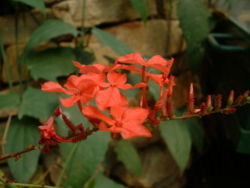Plumbago indica {{{latin_name}}}
|
Plumbago rosea, Scarlet leadwort
|

|
| Habit:
|
|
Shrub
|
| Height:
|
⇕
|
6ft (2m)
|
| Width:
|
⇔
|
3ft (1m)
|
| Lifespan:
|
⌛
|
Tender Perennial
|
| Origin:
|
✈
|
{{{origin}}}
|
| Poisonous:
|
☠
|
{{{poisonous}}}
|
|
| Exposure:
|
☼
|
Sun, Indoors, Greenhouse
|
| Water:
|
◍
|
regular / dry
|
| Features:
|
✓
|
Flowers
|
| Hardiness:
|
☃
|
45F / 7C
|
| Bloom:
|
❀
|
{{{bloom}}}
|
| USDA Zones:
|
|
{{{usda_zones}}}
|
| Sunset Zones:
|
|
{{{sunset_zones}}}
|
|
| [[{{{domain}}}]] >
|
[[{{{superregnum}}}]] >
|
Plantae >
|
[[{{{subregnum}}}]] >
|
[[{{{superdivisio}}}]] >
|
[[{{{superphylum}}}]] >
|
Magnoliophyta >
|
[[{{{phylum}}}]] >
|
[[{{{subdivisio}}}]] >
|
[[{{{subphylum}}}]] >
|
[[{{{infraphylum}}}]] >
|
[[{{{microphylum}}}]] >
|
[[{{{nanophylum}}}]] >
|
[[{{{superclassis}}}]] >
|
Magnoliopsida >
|
[[{{{subclassis}}}]] >
|
[[{{{infraclassis}}}]] >
|
[[{{{superordo}}}]] >
|
Caryophyllales >
|
[[{{{subordo}}}]] >
|
[[{{{infraordo}}}]] >
|
[[{{{superfamilia}}}]] >
|
Plumbaginaceae >
|
[[{{{subfamilia}}}]] >
|
[[{{{supertribus}}}]] >
|
[[{{{tribus}}}]] >
|
[[{{{subtribus}}}]] >
|
Plumbago
|
{{{subgenus}}}
|
{{{sectio}}}
|
{{{series}}}
|
indica
|
{{{subspecies}}}
|
var. {{{cultivar}}}
|
|
Plumbago indica, also known as Plumbago rosea or Scarlet leadwort, is a pot plant originally from India. It enjoys subtropical or warm-temperate climates, or a greenhouse in cool climates.[1]
Plumbago indica has red or pink flowers which appear in the late summer.[2][1]
| Standard Cyclopedia of Horticulture
|
|
syn. Plumbago rosea, Linn. (P. sanguinea, Hort.?). St. zigzag, more or less climbing, glabrous even in the inn.: lvs. large, ovate - elliptic, the short petiole somewhat clasping: fls. purplish red, in long racemes, the corolla- lobes little if any exceeding the exserted part of the tube, the calyx glandular-hairy; base of style hairy. s. Asia. B.M. 230. Var. coccinea, Hook. (P. coccinea, Salisb.), is a form with larger scarlet fls. B.M. 5363. Gng. 1:183. H.T. 11.6:292. This is the form chiefly cult. —Like P. capensis, this species is useful for summer bedding. It is also an excellent subject for winter blooming in pots.
The above text is from the Standard Cyclopedia of Horticulture. It may be out of date, but still contains valuable and interesting information which can be incorporated into the remainder of the article. Click on "Collapse" in the header to hide this text.
|
Cultivation
Propagation
Pests and diseases
Gallery
References
Template:Reflist
- Flora: The Gardener's Bible, by Sean Hogan. Global Book Publishing, 2003. ISBN 0881926248
- American Horticultural Society: A-Z Encyclopedia of Garden Plants, by Christopher Brickell, Judith D. Zuk. 1996. ISBN 0789419432
External links
- ↑ 1.0 1.1 Nico Vermeulen:"The Complete Encyclopedia of Container Plants", p. 216. Rebo International, Netherlands, 1998. ISBN 90-366-1584-4
- ↑ "Botanica. The Illustrated AZ of over 10000 garden plants and how to cultivate them", p 691. Könemann, 2004. ISBN 3-8331-1253-0
